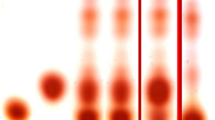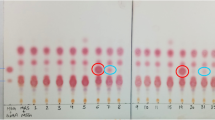Abstract
Kung-Som is a popular traditional Thai fermented shrimp product. It is rich in glutamic acid, which is the major substrate for the biosynthesis of gamma-aminobutyric acid (GABA) by lactic acid bacteria (LAB). In the present study, LAB from Kung-Som were isolated, screened for GABA formation, and the two isolates that transform glutamic acid most efficiently into GABA were identified. Based on the API-CHL50 fermentation profile and a phylogenetic tree of 16S rDNA sequences, strain CS3 and CS5 were identified as Lactobacillus futsaii, which was for the first time shown to be a promising GABA producer. L. futsaii CS3 was the most efficient microorganism for the conversion of 25 mg/mL monosodium glutamate (MSG) to GABA, with a maximum yield of more than 99% conversion rate within 72 h. The open reading frame (ORF) of the glutamate decarboxylase (gad) gene was identified by PCR. It consists of 1410 bp encoding a polypeptide of 469 amino acids with a predicted molecular weight of 53.64 kDa and an isoelectric point (pI) of 5.56. Moreover, a good quality of the constructed model of L. futsaii CS3 was also estimated. Our results indicate that L. futsaii CS3 could be of interest for the production of GABA-enriched foods by fermentation and for other value-added products.




Similar content being viewed by others
References
Diana M, Quílez J, Rafecas M (2014) Gamma-aminobutyric acid as a bioactive compound in foods: a review. J Funct Foods 10:407–420. doi:10.1016/j.jff.2014.07.004
Tajabadi N, Ebrahimpour A, Baradaran A, Rahim RA, Mahyudin NA, Manap MY, Bakar FA, Saari N (2015) Optimization of γ-aminobutyric acid production by Lactobacillus plantarum Taj-Apis362 from honeybees. Molecules 20:6654–6669. doi:10.3390/molecules20046654
Sanchart C, Benjakul S, Rattanaporn O, Haltrich D, Maneerat S (2015) Efficiency of the V3 region of 16S rDNA and the rpoB gene for bacterial community detection in Thai traditional fermented shrimp (Kung-Som) using PCR-DGGE techniques. Songklanakarin J Sci Technol 37:291–297
Li H, Cao Y (2010) Lactic acid bacterial cell factories for gamma-aminobutyric acid. Amino Acids 39:1107–1116. doi:10.1007/s00726-010-0582-7
Dhakal R, Bajpai VK, Baek KH (2012) Production of GABA (γ-aminobutyric acid) by microorganisms: a review. Braz J Microbiol 43:1230–1241. doi:10.1590/S1517-83822012000400001
Daul CB, Slattery M, Reese G, Lehrer SB (1994) Identification of the major brown shrimp (Penaeus aztecus) allergen as the muscle protein tropomyosin. Int Arch Allergy Immunol 105:49–55
Chung CT, Niemela SL, Miller RH (1989) One-step preparation of competent Escherichia coli: transformation and storage of bacterial cells in the same solution. Proc Natl Acad Sci USA 86:2172–2175
Association of Official Analytical Chemists (2005) Official methods of analysis, 18th edn. AOAC International, Virginia
Ratanaburee A, Kantachote D, Charernjiratrakul W, Penjamras P, Chaiyasut C (2011) Enhancement of γ-aminobutyric acid in a fermented red seaweed beverage by starter culture Lactobacillus plantarum DW12. Electron J Biotechnol. doi:10.2225/vol14-issue3-fulltext-2
Populin T, Moret S, Truant S, Conte LS (2007) A survey on the presence of free glutamic acid in foodstuffs, with and without added monosodium glutamate. Food Chem 104:1712–1717. doi:10.1016/j.foodchem.2007.03.034
Arnold K, Bordoli L, Kopp J, Schwede T (2006) The SWISS-MODEL workspace: a web-based environment for protein structure homology modelling. Bioinformatics 22:195–201. doi:10.1093/bioinformatics/bti770
Thompson JD, Gibson TJ, Plewniak F, Jeanmougin F, Higgins DG (1997) The CLUSTAL_X windows interface: flexible strategies for multiple sequence alignment aided by quality analysis tools. Nucleic Acids Res 25:4876–4882
Chao SH, Kudo Y, Tsai YC, Watanabe K (2012) Lactobacillus futsaii sp. nov., isolated from fu-tsai and suan-tsai, traditional Taiwanese fermented mustard products. Int J Syst Evol Microbiol 62:489–494. doi:10.1099/ijs.0.030619-0
Cho SY, Park MJ, Kim KM, Ryu JH, Park HJ (2011) Production of high γ-aminobutyric acid (GABA) sour kimchi using lactic acid bacteria isolated from mukeunjee kimchi. Food Sci Biotechnol 20:403–408. doi:10.1007/s10068-011-0057-y
Lin Q (2013) Submerged fermentation of Lactobacillus rhamnosus YS9 for γ-aminobutyric acid (GABA) production. Braz J Microbiol 44:183–187. doi:10.1590/S1517-83822013000100028
Capitani G, De Biase D, Aurizi C, Gut H, Bossa F, Grütter MG (2003) Crystal structure and functional analysis of Escherichia coli glutamate decarboxylase. EMBO J 22:4027–4037. doi:10.1093/emboj/cdg403
Fan E, Huang J, Hu S, Mei L, Yu K (2012) Cloning, sequencing and expression of a glutamate decarboxylase gene from the GABA-producing strain Lactobacillus brevis CGMCC 1306. Ann Microbiol 62:689–698. doi:10.1007/s13213-011-0307-5
Park JY, Jeong SJ, Kim JH (2014) Characterization of a glutamate decarboxylase (GAD) gene from Lactobacillus zymae. Biotechnol Lett 36:1791–1799. doi:10.1007/s10529-014-1539-9
Park KB, Oh SH (2007) Cloning, sequencing and expression of a novel glutamate decarboxylase gene from a newly isolated lactic acid bacterium, Lactobacillus brevis OPK-3. Bioresour Technol 98:312–319. doi:10.1016/j.biortech.2006.01.004
Acknowledgements
This study was financially supported by the Thailand Research Fund through the Royal Golden Jubilee Ph.D. Program (Grant No. PHD/0060/2556) and Shell Centennial Education Fund, Shell Companies in Thailand. Some part of this research was funded by Prince of Songkla University through Contract No. AGR580355S. The authors thank the Scientific Equipment Center, Prince of Songkla University, Hat Yai, Songkhla, Thailand for their excellent technical assistance.
Funding
This study was funded by the Thailand Research Fund through the Royal Golden Jubilee Ph.D. Program (Grant No. PHD/0060/2556). This study was funded by Shell Centennial Education Fund, Shell Companies in Thailand. This study was funded by Prince of Songkla University through Contract No. AGR580355S.
Author information
Authors and Affiliations
Corresponding author
Ethics declarations
Conflict of interest
The authors declare that they have no conflict of interest.
Electronic supplementary material
Below is the link to the electronic supplementary material.
Fig. S1
Phylogenetic tree of the 16S rDNA sequences of strain CS3 and CS5 with recognized Lactobacillus species. Bootstrap values expressed as percentages of 1000 replications (greater than 50% are shown at the branch points). Bar, 0.01 substitutions per nucleotide position (DOCX 145 kb)
Fig. S2
Cartoon representation of the homology model of the GadB monomer at low pH. The N-terminal domain is colored yellow, the large domain is in pink color, the small domain or C-terminal is shown in deep blue color, and the β-hairpin region is colored green. The PLP-binding domain and motif sheets are colored light blue and white, respectively (DOCX 380 kb)
Rights and permissions
About this article
Cite this article
Sanchart, C., Rattanaporn, O., Haltrich, D. et al. Lactobacillus futsaii CS3, a New GABA-Producing Strain Isolated from Thai Fermented Shrimp (Kung-Som). Indian J Microbiol 57, 211–217 (2017). https://doi.org/10.1007/s12088-016-0632-2
Received:
Accepted:
Published:
Issue Date:
DOI: https://doi.org/10.1007/s12088-016-0632-2




